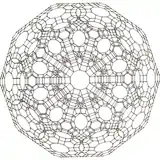Decagonal prism
In geometry, the decagonal prism is the eighth in the infinite set of prisms, formed by ten square side faces and two regular decagon caps. With twelve faces, it is one of many nonregular dodecahedra. The decagonal prism has 12 faces, 30 edges, and 20 vertices, so, it is a dodecahedron (while the term is usually applied to regular dodecahedron or rhombic dodecahedron.). If faces are all regular, it is a semiregular or prismatic uniform polyhedron.
| Uniform decagonal prism | |
|---|---|
 | |
| Type | Prismatic uniform polyhedron |
| Elements | F = 12, E = 30, V = 20 (χ = 2) |
| Faces by sides | 10{4}+2{10} |
| Schläfli symbol | t{2,10} or {10}×{} |
| Wythoff symbol | 2 10 | 2 2 2 5 | |
| Coxeter diagrams | |
| Symmetry | D10h, [10,2], (*10.2.2), order 40 |
| Rotation group | D10, [10,2]+, (10.2.2), order 20 |
| References | U76(h) |
| Dual | Decagonal dipyramid |
| Properties | convex, zonohedron |
 Vertex figure 4.4.10 | |
Uses
The decagonal prism exists as cells in two four-dimensional uniform 4-polytopes:
| Runcitruncated 120-cell |
Omnitruncated 120-cell |
 |
 |
Decagonal prisms are often used in combination locks.
Related polyhedra
| Family of uniform n-gonal prisms | |||||||||||||
|---|---|---|---|---|---|---|---|---|---|---|---|---|---|
| Prism name | Digonal prism | (Trigonal) Triangular prism |
(Tetragonal) Square prism |
Pentagonal prism | Hexagonal prism | Heptagonal prism | Octagonal prism | Enneagonal prism | Decagonal prism | Hendecagonal prism | Dodecagonal prism | ... | Apeirogonal prism |
| Polyhedron image | ... | ||||||||||||
| Spherical tiling image | Plane tiling image | ||||||||||||
| Vertex config. | 2.4.4 | 3.4.4 | 4.4.4 | 5.4.4 | 6.4.4 | 7.4.4 | 8.4.4 | 9.4.4 | 10.4.4 | 11.4.4 | 12.4.4 | ... | ∞.4.4 |
| Coxeter diagram | ... | ||||||||||||
External links
This article is issued from Wikipedia. The text is licensed under Creative Commons - Attribution - Sharealike. Additional terms may apply for the media files.